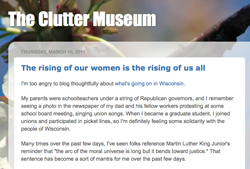Back in my cultural studies grad school days, I heard frequent exhortations by left-leaning professors that the classroom is inherently a political space and we should be open about our own political stances. About half of the faculty I heard this from seemed to be saying that students’ own beliefs need challenging (and broadening), while the other half seemed to suggest that only if we come clean about our own political commitments can we be considered good teachers. After all, we can’t go about criticizing white male [philosophers, scientists, historians, curators, politicians] for adopting a “view from nowhere” if we ourselves aren’t situating our knowledge or, in the case of teachers, our presentation of allegedly objective knowledge, in the context of our cultural habits, beliefs, and values.
Here in Idaho, many of my students aren’t especially eager to hear my feminist perspective on issues. (On several occasions, I have had male students name the “worst professors” in my college as the ones I’m guessing are most likely to present an overtly feminist perspective on the past and present.) I deliver this same perspective in my courses, I suspect, but it’s much more moderated than it was when I was standing in the front of California classrooms. I still present the same ideas, but I’m more likely to counterbalance them with ideas to which my most conservative students will be more sympathetic.
So, for example, in the first “half” of the history survey, I have them read Clarence Walker’s Mongrel Nation and we discuss it for a couple of days, but I also have them look at the Thomas Jefferson Heritage Society’s Scholars Commission report on l’affaire Hemings. I emphasize slavery and gender and a relatively countercultural view of U.S. history throughout the semester, and then we read the Texas state standards for U.S. history. For me, it’s not a matter of perfect balance–I do usually take a stance at the end of each activity–but of challenging students from both sides of the political spectrum with inconvenient facts. While my students are WTF?ing about why Jefferson isn’t more prominent and asking if the Texas standards aren’t some kind of conspiracy by the extreme right, I ask them why they don’t know more about “Benjamin Rush, John Hancock, John Jay, John Witherspoon, John Peter Muhlenberg, Charles Carroll, and Jonathan Trumbull Sr.”–the founding fathers deemed most significant by the Texas state board. Could that be some kind of conspiracy? (Cue sound of minds being blown.) Such moments open good discussions about how all textbook historiography is political and that history gets practiced by all kinds of people for all kinds of ends. (Example: Why are so many of the students in my class required to take the wide-ranging survey course instead of courses that would allow them greater space to examine issues in depth?)
My point is this: I make clear to my students that most of them are going to consider me a flaming liberal/crazy Californian/just the type of person who is ruining Idaho. But then I win their trust, and they usually consider my position.
I owe a good deal of credit to Fang; as I was maturing out of my early-twenties jejeunosity, he modeled the whole walking-a-mile-in-someone-else’s-perspective thing exceptionally well. And he’s still really, really good at it.
I like to think I can be, too.
But there are a couple of issues where I just can’t moderate myself–as anyone who has seen my FB postings the last couple of days can attest.
Gun violence is one of those.
And yet I moved from a state (California) that scored 81 on the Brady Campaign’s scorecard to one that earned–wait for it–a 2. And not surprisingly (to me, at least), Idaho is also one of the states where people are more likely to kill themselves or others with a gun, accidentally or intentionally. (Not surprisingly, the map of that data bears a strong resemblance to the 2012 presidential election results.)
People on all sides of the gun control debate (and isn’t that all of us?) let emotion control their beliefs and habits. (Fear, mostly.) As we try to figure out how to feel more secure despite this fear, we draw on whatever personal experience we have, whether that be first-hand experience with guns or the cultural context in which we came to know about gun violence.
Over the next several days, I’m going to share a lot of links I’ve been collecting about gun violence, gun control, and gun ownership. There’s going to be a lot of data and logic, and much of it is going to–surprise!–point out that more regulation of guns is a good idea. There will also be a good deal of personal reflection–this is my personal/academic blog, after all, so the posts are all but required to aspire to public intellectualism before devolving into maudlin solipsism. First, though, I want to don my good-teacher cardigan and position myself vis-à-vis this subject. Here are a few not-so-random, er, bullets that may not yet seem to all be related to the same theme:
- The first time I saw a gun in person, it was my grandfather’s service revolver. He was a retired police officer, and he told me I should never, ever touch a handgun. (In the same room–my grandparents’ bedroom–many years later, as he lay dying, he would tell me to stay away from alcohol, drugs, and fast women. He died when I was only 15 years old, but in later years I learned from my grandmother that he was sort of a walking cautionary tale.)
- My grandmother disposed of the handgun almost immediately after Grandpa died. Very shortly thereafter, a mentally ill man who had gone off his meds tried to punch through the glass on Grandma’s front door. He wanted to injure the home’s inhabitants, and yes, he had known there was a gun not far from the front door when Grandpa was alive. The first thing Grandma said to me after the incident was that she was so glad she had gotten rid of that gun.
- I grew up in a household free of guns.
- When I was in high school, I regularly heard gunshots in the neighborhood as I was waiting to be picked up from orchestra practice on Wednesday nights.
- There were many, many gang members in my high school.
- I was in high school in Long Beach during the Los Angeles riots. I watched the violence unfold on TV at night, then drove to school the next morning to find the occasional building burned down between my house and the school. Never, however, did I feel unsafe.
- My senior year, I wrote the obituary page in my high school yearbook.
- When I was a student there, my high school was 20 percent white. There were 50+ languages spoken at home by its students.
- I feel most white not when I’m the only white person in a crowd, but when I’m in a crowd full of white people. I’ve never felt more conscious of my whiteness than I have in Idaho.
- The only time I feared for my safety sufficiently that I went straight to a police station was when I was pursued on a bike by a white man in Fredericksburg, Virginia. (I was 18.)
- I have been a vegetarian for more than two decades, and I aspire to be vegan. When I really commit myself I can be vegan for weeks on end, and I look and feel awesome.
- I have a history of serious depression, and I’m not the only one in my home who struggles with it.



I was shocked to discover how lax Vermont’s gun laws are. Off to start writing my local legislators now!